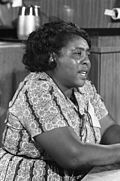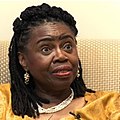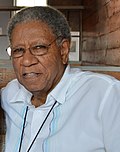Student Nonviolent Coordinating Committee
The Student Nonviolent Coordinating Committee (SNCC, often pronounced /snɪk/ SNIK) was the main channel of student activity to the Civil Rights Movement in the 1960s.
| Student Nonviolent Coordinating Committee (SNCC) | |
|---|---|
| 200px | |
| Formation | 1960 |
| Extinction | 1976 |
| Purpose/focus | Pacifism Civil Rights Movement Anti-racism Participatory democracy Black power |
| Headquarters | Atlanta, Georgia |
| Main organ | The Student Voice (1960–1965) The Movement (1966–1970) |
| Affiliations | |
They were a group of students who wanted to show segregation was wrong. They would sit in white only shops and cafes and refuse to move even if they were attacked.
It was created in 1960 from the student-led sit-ins to protest segregated lunch counters in Greensboro, North Carolina and Nashville, Tennessee. The group was mainly founded and headed by Ella Baker.
Student Nonviolent Coordinating Committee Media
John Lewis representing SNCC at the Civil Rights March on Washington in 1963
One man, one vote button which was probably worn at an SNCC event
Photograph of Gwendolyn Zoharah Simmons, taken during 2011 oral history interview.
John Lewis representing SNCC at the Civil Rights March on Washington in 1963
Other websites
- The SNCC Digital Gateway
- The SNCC Project: A Year by Year History 1960–1970
- SNCC Actions 1960–1970 (map)
- SNCC 1960 – 1966: Six years of the Student Nonviolent Coordinating Committee. Retrieved May 2, 2005.
- Stokely Carmichael – Leader of SNCC's militant branch Archived 2010-04-19 at the Wayback Machine
- Civil Rights Movement Veterans
- SNCC Documents Online collection of original SNCC documents ~ Civil Rights Movement Veterans.
- Americus Movement Archived 2014-05-24 at the Wayback Machine, Civil Rights Digital Library.
- The Story of SNCC Archived 2017-07-15 at the Wayback Machine, One Person, One Vote Project








